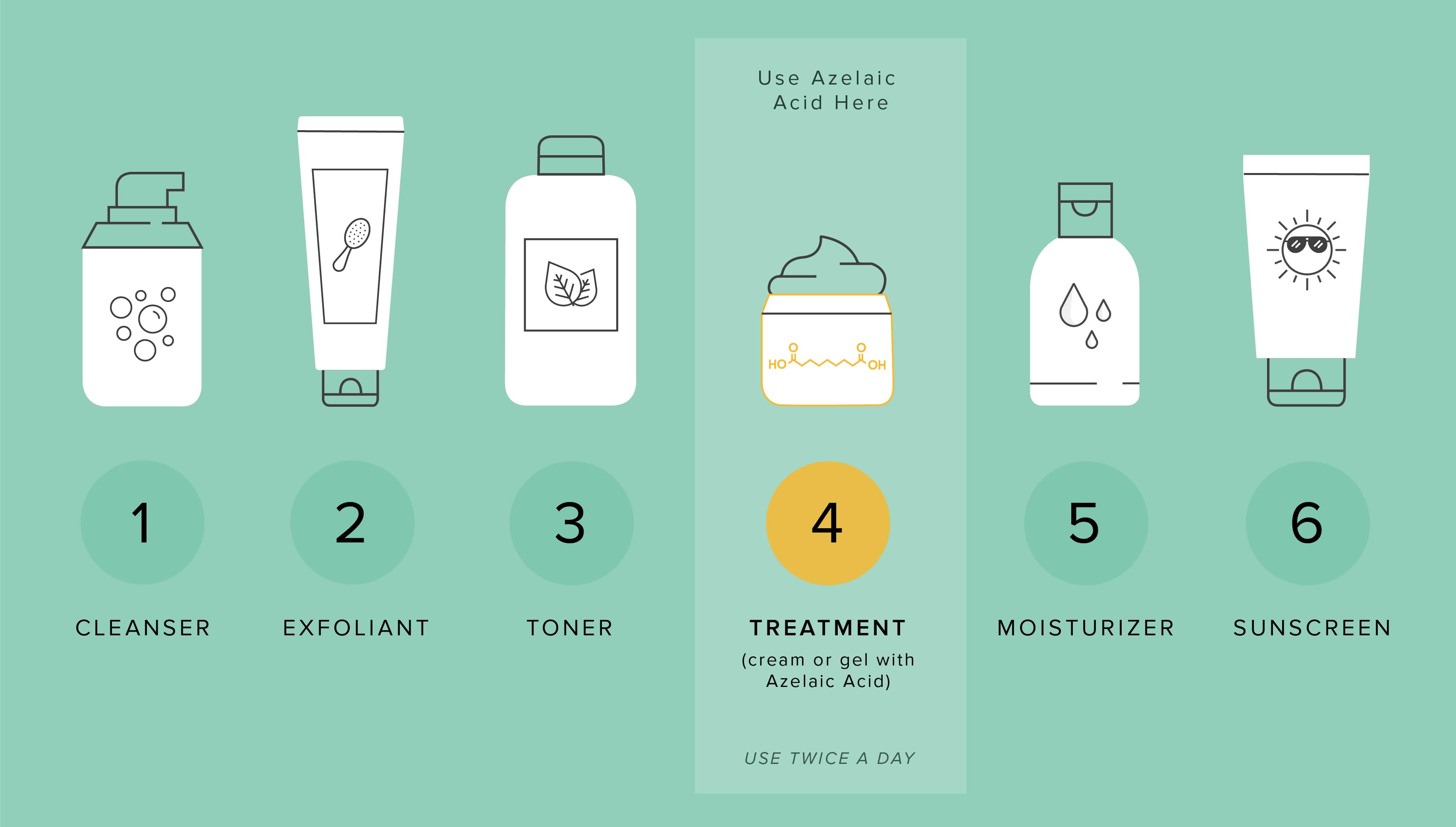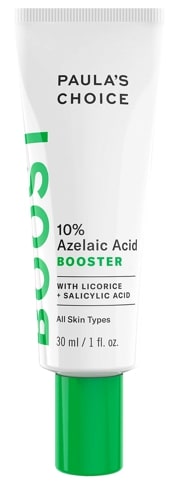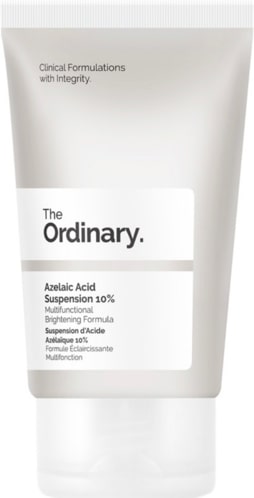Azelaic Acid Skin Care Benefits:
All You Need to Know
Azelaic acid is an FDA approved skin care ingredient used for the topical treatment of acne and rosacea. Azelaic acid is antibacterial, meaning it kills acne bacteria in existing pimples. In fact, azelaic acid is so tough against acne bacteria that it's an OTC option for treating cystic acne and has been studied to be almost as effective as Accutane. Azelaic acid is a keratolytic meaning it exfoliates dead skin cells and is also a comedolytic meaning it prevents future whiteheads and blackheads from forming. Azelaic acid lightens acne scars as well as melasma, and it's anti-inflammatory properties calm rosacea and redness. Even though azelaic acid is a powerful ingredient, it's gentle on the skin and safe for all skin types. Azelaic acid is naturally occurring in whole grains like barley, wheat, and rye, but mostly synthetic versions are used in skincare products for greater stability and overall effectiveness.
Azelaic Acid
INGREDIENT CATEGORY: Antiseptic, Keratolytic
BEST FOR TREATING: Acne & Blemishes, Acne Scars, Mild Melasma, Redness, Rosacea
SKIN TYPES FOR USE: All
SAFETY: Azelaic acid is safe for topical use in concentrations of up to 20% in skin care products
GHS TIP: It will take 6-8 weeks of consistent topical use of azelaic acid before you begin to see improvements
Top 6 Azelaic Acid Skin Care Benefits
✓ Fights Acne Bacteria
GREAT FOR MODERATE TO SEVERE ACNE
A long-established ingredient, azelaic acid is best known for the treatment of acne. Azelaic acid is antibacterial meaning it works to kill acne bacteria, and unlike many other acids that fight acne (salicylic, glycolic, and alpha hydroxy acids), azelaic acid is an OTC option that's actually strong enough to fight cystic acne. Azelaic acid combats acne by diving deep into your pores and decreasing the free fatty acid content in your skin. This creates a skin environment that’s less friendly to acne bacteria. There is also evidence that azelaic acid disrupts normal cellular function of acne bacteria, effectively killing it from the inside out.
✓ Safer than Accutane
GENTLER & NONTOXIC OPTION
Accutane is a branded, prescription acne medication which contains the acne fighting ingredient isotrentinoin (a derivative of Vitamin A). Even though Accutane is exceptionally effective at clearing severe, cystic acne, it comes at the risk of various side effects, some more serious than others. For example, Accuatane can cause skin irritation, dry skin and dry lips, but it also can cause birth defects (women who are pregnant or may become pregnant cannot be prescribed Accutane). For those looking for a strong acne treatment but without the scary side effects, azelaic acid is a safer option. In a comparison of azelaic acid cream to oral isotretinoin in the treatment of severe acne, researchers found that azelaic acid was almost as effective as isotrentinoin at treating severe acne with considerably less skin irritation and no risk of birth defects.
✓ Prevents Future Acne
KEEPS PORES CLEAN
Azelaic acid is a comedolytic meaning it prevents future whiteheads and blackheads from forming. By keeping pores clean, whiteheads and blackheads won't develop from excess oil or dead skin cell buildup. FYI, salicylic acid and benzoyl peroxide are also comedolytics.
✓ Removes Dead Skin Cells
UNCLOGS PORES
Azelaic acid increases the turnover rate of dead skin cells, and as dead skin cells see their way off your face, your pores are left nice and clean. The scientific reason is azelaic acid has keratolytic properties (like ingredients salicylic acid and benzoyl peroxide). And why do we care? Having unclogged, clearer pores prevents future acne from developing.
✓ Lightens Melasma and Acne Scars
TREATS MILD HYPERPIGMENTATION
Azelaic acid lightens hyperpigmentation by reducing melanin production in hyperactive areas (darker spots on the skin). Azelaic acid limits melanin creation by inhibiting tyrosinase, an enzyme needed for the production of melanin in your skin. Fancy way of saying azelaic acid prevents the enzyme from doing its thing, and the melanin production line comes to a halt. Less melanin being created is what fades hyperpigmentation, especially dark areas not caused by the sun. All in all, the topical treatment of azelaic acid decreases melanin which fades hyperpigmenation like melasma and acne scars. Unfortunately, azelaic acid does not fade freckles or age/sun spots as effectively.
✓ Anti-Inflammatory
SOOTHES ROSACEA (REDNESS) AND ACNE
Azelaic acid is an anti-inflammatory, meaning less redness, pain, and swelling from acne, rosacea, or other types of inflammation. For acne-prone skin, azelaic acid calms breakouts and prevents new pimples from developing. For those with rosacea, azelaic acid calms redness by soothing the underlying inflammation that causes rosacea. Plus, azelaic acid is milder than other antibacterial agents, making it a prime ingredient to gently exfoliate and clean pores without irritating rosacea or sensitive skin in general.
When to Use Azelaic Acid
SKIN CARE ROUTINE OPTION:
A cream or gel with azelaic acid - use 2x a day

How to Apply Azelaic Acid
Work up to it!
Always patch test before applying to your entire face! Start by applying the azelaic acid product in the evening to a small area on your forehead (where your facial skin is thickest). If there’s no irritation within 24 hours, apply a thin layer of product to your entire face every evening. If there’s no irritation after a week and you want to get more aggressive with the treatment, begin applying the azelaic acid product both morning and night.
FYI: slight tingling and/or redness are both totally normal when applying azelaic acid.

Apply to entire face
Azelaic acid works best when applied to your entire face (avoid eyes, lips, and mouth) because it removes dead skin cells from your pores and fights to prevent acne bacteria from growing. This helps prevent future breakouts...and obviously you want to prevent that.

Follow Up With...
Use a moisturizer twice a day to balance out the drying effects from azelaic acid.
This is critical. Azelaic acid makes your skin more sensitive to UV rays. Limit your time in the sun and apply sunscreen daily.
Azelaic Acid in Products


Acne & Blemishes
Acne Scars
Mild Melasma
Redness
Rosacea


All Skin Types!


Creams/Gels


Over the Counter
Prescribed Medication
Top 3 Azelaic Acid Skin Care Products
We’ve put together a GHS curated selection of our favorite skin care products that contain azelaic acid for fighting acne, brightening your skin, and soothing redness. We only link to products that we absolutely believe in. All the products we’ve chosen are paraben-free, sulfate-free, and phthalate-free. Remember - results won’t happen overnight. It will take 6-8 weeks of consistent topical use before you begin to see improvements, so stay consistent with your product usage.
Use in AM & PM
Apply this serum to your face post cleansing, exfoliating, toning, and any vitamin C serum.
Price $
Certified: paraben-free, sulfate-free, phthalate-free, cruelty-free, vegan, gluten-free
Use in AM & PM
Apply this serum to your face post cleansing, exfoliating, toning, and any vitamin C serum.
Price $$
Certified: paraben-free, sulfate-free, phthalate-free, cruelty-free, vegan, gluten-free
Use daily in AM or PM
Apply this cream to your face post cleansing, exfoliating, toning, and any vitamin C serum.
Price $$$$
Certified: paraben-free, sulfate-free, phthalate-free
Check out all of our favorite azelaic acid products for fighting acne or rosacea.
GHS Tips
Consistency is key
Results won’t happen overnight. Consistency is key. It will take 6-8 weeks of consistent topical use before you begin to see improvements. Be patient - good things come to those who wait. If you don’t see improvement after 90 days, then we recommend trying a different azelaic acid product or another acne fighting ingredient like adapalene, benzoyl peroxide, or salicylic acid.

15% to 20% is best
The most effective azelaic acid skin care products are prescription-only gels (shocker) with concentrations of 15% to 20%. These aren’t for everyone - higher azelaic acid concentrations can be very irritable for those with sensitive skin. Consult your dermatologist if you’re trying a more aggressive approach.

Safety Tips
Azelaic acid is FDA Approved and safe for topical use in concentrations of up to 20% in skin care products.
SIDE EFFECTS OF AZELAIC ACID SKIN PRODUCTS:
- dryness, itching, or peeling
- burning or tingling
✓ Wear sunscreen!
✓ Consider consulting a dermatologist - let them determine the right azelaic acid concentration for you
X Don't use to treat freckles or age spots - azelaic acid is not effective on them -- if you want to fade freckles and/or age spots, try a product with either vitamin C, kojic acid, or arbutin
FAQs about Azelaic Acid
Q. What is azelaic acid?
Azelaic acid is a naturally occurring compound found in whole grains like barley, wheat, and rye. However, the synthetic form of azelaic acid is more often used in skincare products because of its stability and effectiveness.
 Q. What is azelaic acid used for in skin care?
Q. What is azelaic acid used for in skin care?Azelaic acid is used to treat the following skin concerns:
- Acne & Blemishes
- Acne Scars
- Mild Melasma
- Redness
- Rosacea
 Q. How does azelaic acid benefit my skin?
Q. How does azelaic acid benefit my skin?The top 6 azelaic acid skin benefits are:
- Fights acne bacteria
- Removes dead skin cells
- Prevents future acne
- Anti-inflammatory
- Lightens melasma and acne scars
- Safer than Accutane
 Q. What skin types is azelaic acid good for?
Q. What skin types is azelaic acid good for?Azelaic acid is safe to use on all skin types.
 Q. Is azelaic acid safe for my skin?
Q. Is azelaic acid safe for my skin?Azelaic acid is safe for topical use in concentrations of up to 20% in skin care products.
 Q. What are common side effects from applying azelaic acid topically?
Q. What are common side effects from applying azelaic acid topically?Dryness, itching or peeling, and burning or tingling can be common side effects from applying azelaic acid topically. Always be sure to do a patch test on your skin before applying a new product to your entire face.
 Q. How long does azelaic acid take to work topically?
Q. How long does azelaic acid take to work topically?It will take 6-8 weeks of consistent topical use of azelaic acid before you begin to see improvements. Remember - consistency is key for optimal results. Results will not happen overnight.
 Q. Can azelaic acid be used as a peel?
Q. Can azelaic acid be used as a peel?No, azelaic acid is an ingredient that works over time with consistent application. If you're looking for something quick and intense, consult an esthetician for a glycolic acid or salicylic acid peel.
 Q. Is azelaic acid effective on age spots or freckles?
Q. Is azelaic acid effective on age spots or freckles?No, azelaic acid is not effective on age spots or freckles - if you want to fade freckles or age spots, try a product with either vitamin C, kojic acid, or arbutin.
 Q. How does azelaic acid compare to alpha hydroxy acids (AHAs) or salicylic acid (BHA)?
Q. How does azelaic acid compare to alpha hydroxy acids (AHAs) or salicylic acid (BHA)?Although azelaic acid is similar to these ingredients due to its exfoliating capabilities, azelaic acid does not exfoliate the same way and is not as effective of an exfoliant as alpha hydroxy acids (AHAs) are for treating hyperpigmentation. However, azelaic acid offers additional benefits that AHA and BHA ingredients don’t provide - it’s great for helping treat rosacea due to its anti-inflammatory and anti-bacterial properties. What to do? Consider using an AHA or BHA exfoliant along with an azelaic acid product. This combination can be ideal for addressing multiple skin concerns, from acne and blemishes to uneven skin tone to age-related concerns you may be struggling with.
 Q. Can I use azelaic acid with alpha hydroxy acids (AHAs)?
Q. Can I use azelaic acid with alpha hydroxy acids (AHAs)?Yes, but with caution. This is a great combo if you are looking to treat hyperpigmentation or fine lines and wrinkles. If you are going to use azelaic acid and alpha hydroxy acids together, look for a formula that combines the acids together at lower percentages or use them on alternating days to avoid increasing your chances of irritation.
 Q. Can I use azelaic acid with salicylic acid?
Q. Can I use azelaic acid with salicylic acid?Absolutely! This is a great combo if you are looking to treat acne and blemishes. If you are going to use azelaic acid and salicylic acid together to fight breakouts, look for a formula that combines the acids together at lower percentages or use them on alternating days to avoid increasing your chances of irritation.
 Q. Can I use azelaic acid with retinol?
Q. Can I use azelaic acid with retinol?Yes, but use with caution. If you are going to use azelaic acid and retinol together, use the azelaic acid product in the morning and the retinol product in the evening, or use them on alternating days to avoid increasing your chances of irritation.
 Q. Can I use azelaic acid with vitamin C?
Q. Can I use azelaic acid with vitamin C? Yes, azelaic acid can be used with vitamin C. However, if you are using both in your skin care routine, use vitamin C in the morning and azelaic acid at night. Vitamin C fights to neutralizes free radicals and since free radicals are formed while your skin is exposed to the sun and environmental factors, using it in the evening isn’t necessary.
 Q. Can azelaic acid remove acne scars?
Q. Can azelaic acid remove acne scars?Yes, azelaic acid can help remove acne scars.
 Q. Can azelaic acid permanently lighten skin?
Q. Can azelaic acid permanently lighten skin?No, azelaic acid does not have the capability to permanently lighten your skin - it is not destroying melanin - it simply disrupts/slows melanin production. However, azelaic acid has the capability to lighten mild melasma or post-inflammatory hyperpigmentation (acne scars and dark spots) due to its ability to inhibit tyrosinase, an enzyme needed for the production of melanin.
 Q. Does azelaic acid cause purging?
Q. Does azelaic acid cause purging? Yes. Azelaic acid speeds up your skin cell turnover rate - this makes microcomedones turn into acne and blemishes more quickly, causing a sudden rush of breakouts on your face. Surprisingly, this is not a bad thing (no, we aren't joking). It actually means your azelaic acid product is working. However, if the product is causing you to break out in places you don’t normally break out, or your acne has become inflamed, then this is a negative reaction. In this case, you should discontinue using the product because it’s irritating your skin.
 Q. How long does the “purge” time period last?
Q. How long does the “purge” time period last? Purging should only last up to a month - if your skin isn’t getting better after 6-8 weeks using the product, than ditch it.
 Q. Does azelaic acid bleach clothes?
Q. Does azelaic acid bleach clothes?No, azelaic acid does not bleach clothing or towels.
 Q. Do azelaic acid skin care products expire?
Q. Do azelaic acid skin care products expire?Yes. Look for the expiration date or a POA (prescribed period after opening) which tells you how long the product is good after it’s been opened. If your azelaic acid product has expired, do not use it - expired products can cause skin irritation, bacterial infection, or breakouts.
 Q. What are common names used to identify azelaic acid on an ingredient list for skin care products?
Q. What are common names used to identify azelaic acid on an ingredient list for skin care products?
- Azelaic Acid
 Q. What professinal skin care brand products contain azelaic acid?
Q. What professinal skin care brand products contain azelaic acid?
- Azelex (contains 20% azelaic acid)
- Finacea (contains 15% azelaic acid)

Want More GHS Tips?
It’ll be the best thing to ever slide into your DM's.


